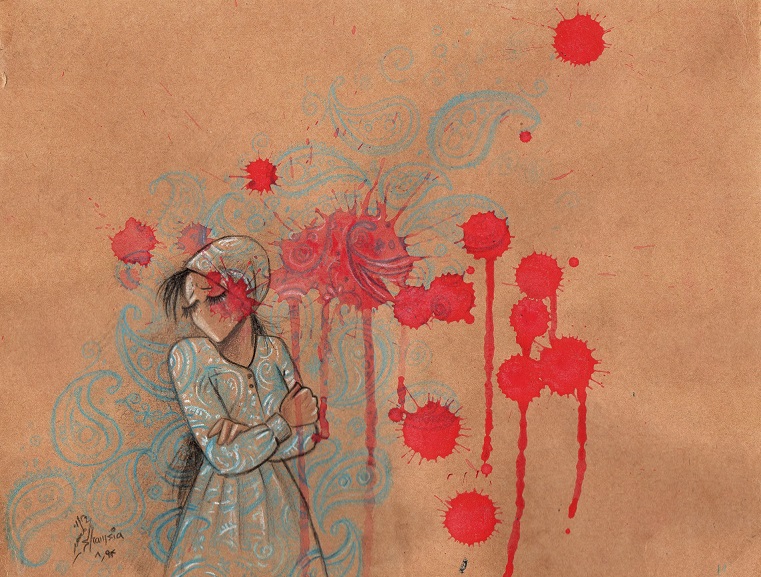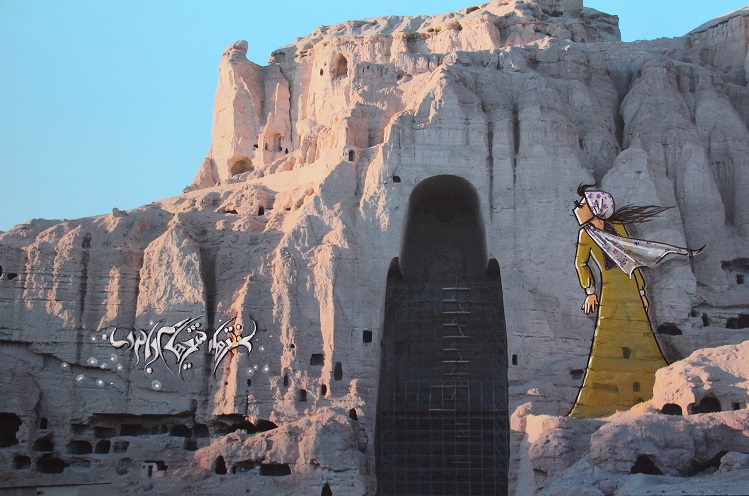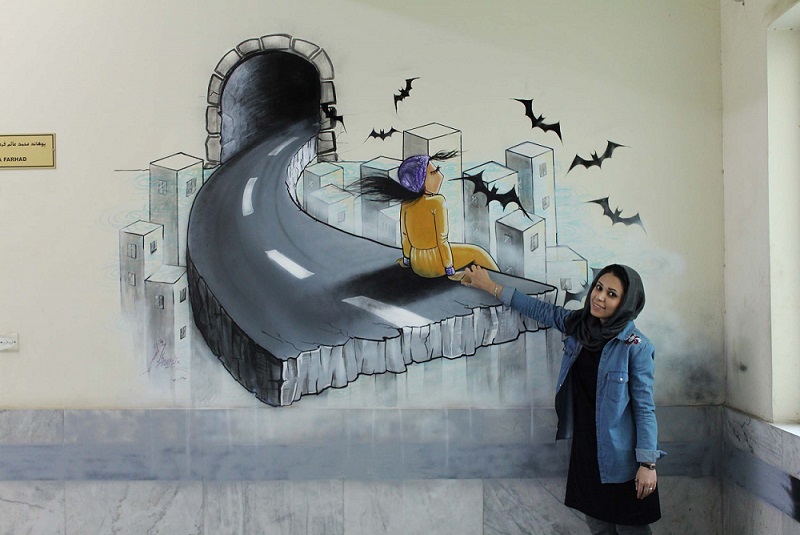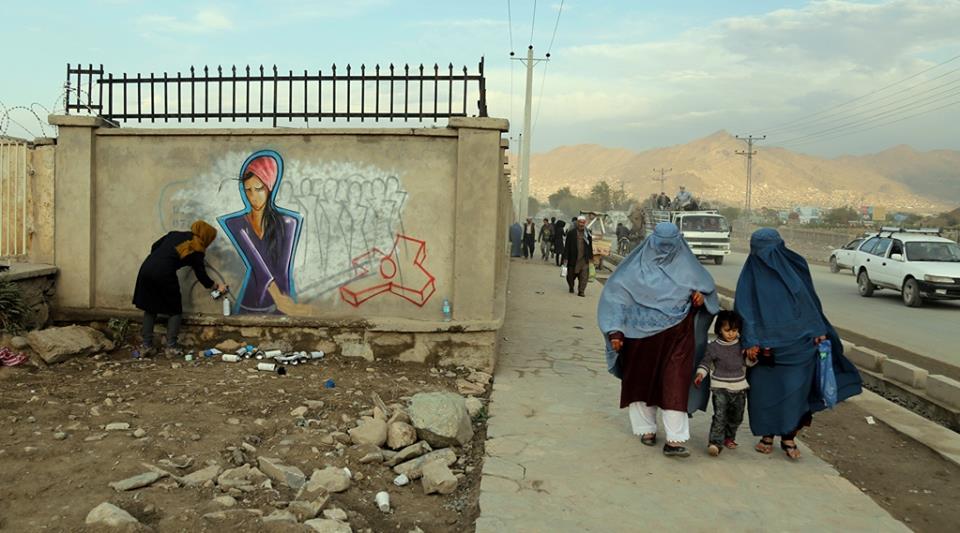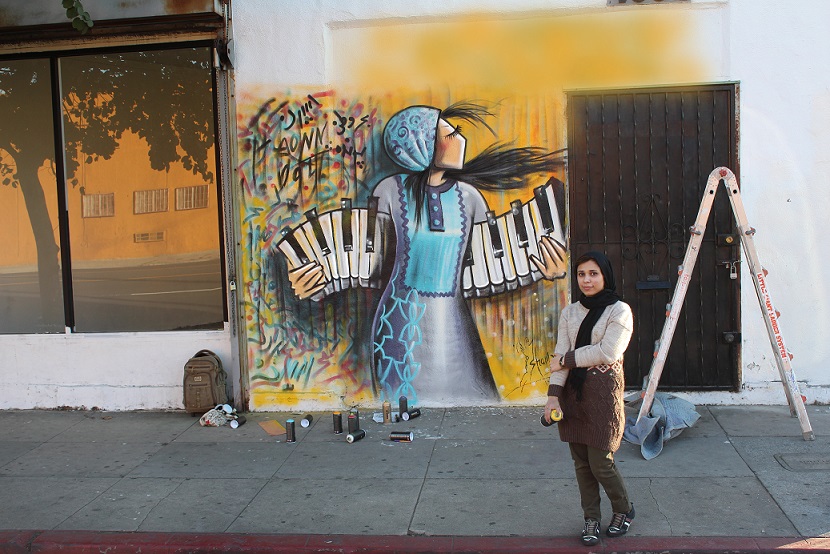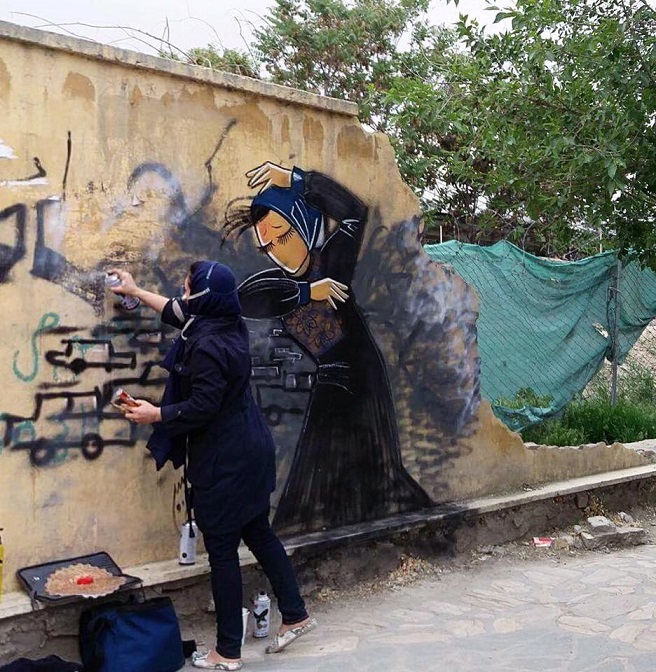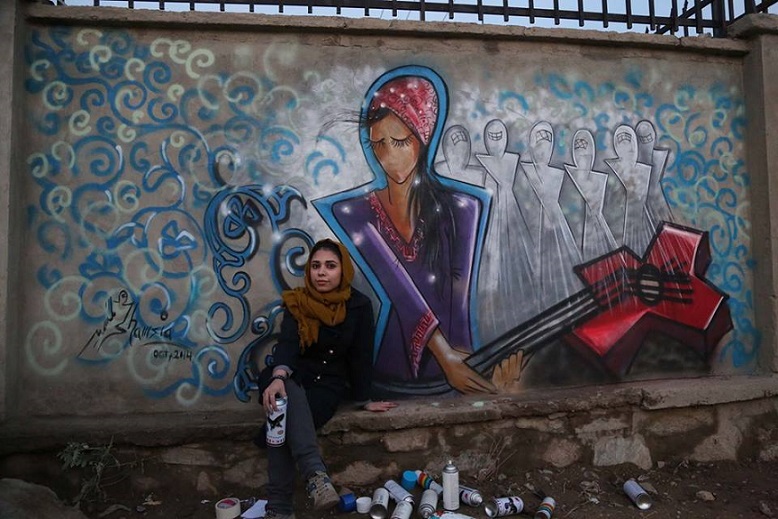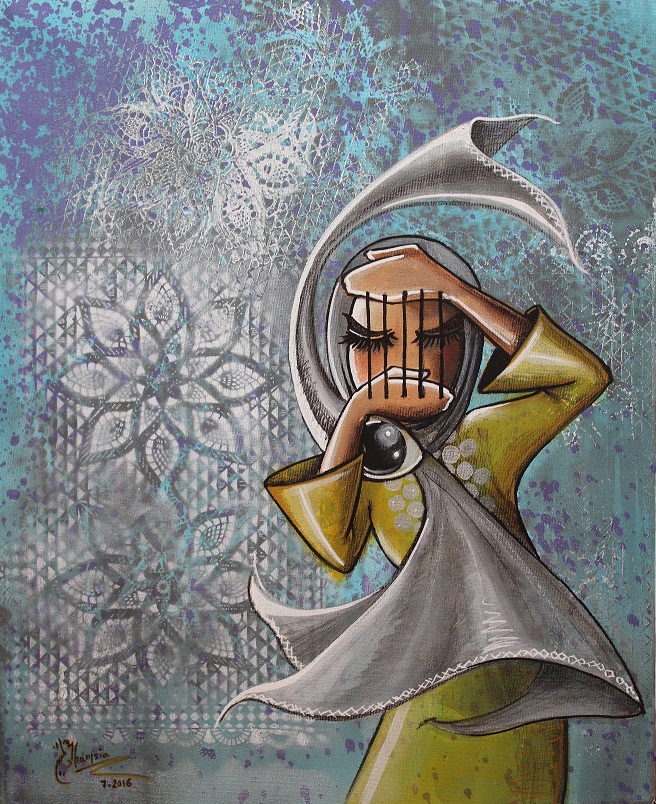Shamsia Hassani, além de ser uma artista, é uma inspiração para muitas mulheres. Ela desafia os padrões patriarcais do seu país e enfrenta constantemente o medo e o preconceito designado do que significa ser uma mulher artista em Kabul, transmitindo uma mensagem de empoderamento para as mulheres afegãs. Professora da Universidade de Kabul e artista conceituada mundialmente, seus trabalhos foram expostos em galerias de vários países. Conversamos com Shamsia em uma entrevista exclusiva, onde ela nos conta um pouco sobre seu trabalho e as dificuldades que enfrenta. Confira!
DN – Quando você começou a se interessar por arte, especificamente pelo grafite? Você sempre quis trabalhar com arte ou já se interessou por outros estudos?
Shamsia – Sendo uma refugiada no Irã, nos anos escolares, eu fiz desenhos na sala de aula. Lembro quando minha professora viu meu primeiro desenho; ela não acreditou que eu havia feito. Ela me perguntou se alguém tinha feito para mim. Eu disse que não, que eu mesma fiz.
Ela me pediu para fazê-lo novamente, e eu fiz. Ainda me lembro que ela estava surpresa e sorriu carinhosamente. Eu sempre tive interesse em aprender artes, mas no Irã nós mulheres não tínhamos permissão, como tenho no Afeganistão.
Após a queda do Talibã, retornei ao Afeganistão e entrei na Faculdade de Belas Artes, na Universidade de Kabul, onde estudei. No ano de 2010, em Kabul, o Combat Communication convidou CHC, um artista grafiteiro do Reino Unido para expor seu trabalho no Afeganistão. Foi aí que eu realmente passei a me interessar por grafite e minha jornada começou.
DN – O que te motivou a levar seu trabalho para as ruas de Kabul? E quais suas maiores inspirações?
Shamsia – Pra mim é muito importante introduzir arte para o meu povo. Antes de fazer grafite eu não sabia como apresentar a arte para as pessoas, como introduzir as pessoas para a arte, porque não há galerias e exibições.
O tamanho enorme do grafite e como ele é facilmente acessível para as pessoas foi o que fez com que eu começasse a produzir grafite. Vi que há centenas de muros com sinais de guerra (balas, muros quebrados e danificados). Senti que com o grafite eu poderia remover estes sinais da guerra e, além disso, fazer arte. Essas foram as motivações pelas quais eu fui encorajada de fazer arte de rua.
Minha sociedade, as pessoas e os elementos positivos e negativos do meu país são as minhas inspirações para produzir arte. Quanto mais eu vejo, mais há coisas para falar sobre.
DN – Você sempre recebeu apoio da sua família nos estudos e também quando decidiu que gostaria de levar o seu trabalho para as ruas de Kabul? Como sua família lidou com isso?
Shamsia – Meus familiares sempre apoiaram o meu trabalho. Meu pai – que é um carpinteiro e projeta esculturas em madeiras – sempre acreditou no meu trabalho. Minha mãe, irmã, irmão e cunhado também me apoiaram muito. Eu me lembro quando fiz meu primeiro grafite 3D e meu cunhado ficou extremamente entusiasmado. Eu quis apresentar meu trabalho em uma parte da cidade de Kabul e ele me ajudou muito.
DN – Como professora, como você enxerga o ensinamento artístico em seu país? Há dificuldades e limitações para as mulheres que querem aprender e ensinar arte? Quais as melhorias que você recomendaria?
Shamsia – No Afeganistão, questões religiosas e de segurança têm forçado as famílias a manterem suas filhas, esposas e irmãs fora das artes. As famílias acreditam que estão mantendo as mulheres em segurança afastando elas da escola e do ensinamento artístico.
Algumas limitações são mantidas pelas próprias mulheres. Por exemplo, as meninas não saem de casa tarde, elas não vão a universidade ou a centros culturas depois de escurecer, pois acreditam que não é seguro, então elas limitam a si mesmas. Assim, as famílias acreditam que se as suas mulheres não saírem de casa, elas estarão seguras e não terão problemas. Religiosos no Afeganistão gostam de artes, mas não gostam que as mulheres da família se tornem artistas.
Observando por um lado positivo, desde a última década eu vejo várias artistas no Afeganistão. Eu me lembro de quando entrei na Universidade em 2005 e havia algumas garotas estudando arte. Agora mudou, há mais mulheres entrando na Universidade e estudando arte. Eu acredito que há mais pessoas tentando estudar arte.
Sobre as melhorias, há algumas questões que nos impedem de melhorar o estado atual da arte no Afeganistão. Por exemplo, se você deseja abrir uma galeria no Afeganistão, você enfrentará muitos problemas com questões de segurança. Além disso, questões políticas levam as pessoas a não acompanharem a arte ou se tornarem artistas.
Por exemplo, se alguém quer abrir uma loja de materiais de arte, ele ou ela enfrentará uma grande perda, pois ninguém comprará o material. Então, não é que melhorar as artes seja algo difícil de se conseguir, mas melhorar outros fatores que fazem com que as artes parem de evoluir.
Leia Também:
[ENTREVISTA] Minna Miná: Arte, autenticidade e fantasia
[ENTREVISTA] Natália Lima e Sapo Lendário: Arte, meninas fortes e influência japonesa
[ENTREVISTA] Duda TÖFU: Ilustração como terapia
DN – Como ocorre o processo artístico quando está nas ruas de Kabul? Há uma preparação antes de ir para as ruas?
Shamsia – Há muitas preparações, especificamente encontrar um muro, um local seguro e fazer stencil para agilizar meu trabalho. Primeiro eu tenho que encontrar um muro e ver se é necessário uma permissão. Normalmente as pessoas não gostam que você pinte o que quiser, elas pedem pra que você desenhe algo que elas gostem.
Elas têm suas próprias solicitações relacionadas com o que deveria ser desenhado em suas propriedades, elas não querem o meu trabalho artístico. Segundo, eu tenho que ser ligeira e fazer o meu trabalho o mais rápido que conseguir. Sempre há pessoas nas ruas que não querem que as mulheres façam isso. Eu fico assustada, então eu tento fazer o mais rápido possível. Para fazer a minha arte rapidamente eu desenho meu rascunho, crio stencil e separo todas as cores antes de sair para a rua para fazer o trabalho.
DN – O que significa para você ser uma artista mulher ocupando espaços públicos nas ruas de Kabul? Você enfrenta muito preconceito? Existe um medo constante?
Shamsia – Depois que comecei com o grafite, a situação da segurança piorou e eu não pude sair para fazer grafite. Eu era uma artista de rua que não podia fazer grafite. Incluindo a segurança, houve mais alguns problemas que estava enfrentando. Por exemplo, as pessoas no Afeganistão não são contra a arte, mas atividades feitas por mulheres. Então quando as pessoas me veem nas ruas fazendo grafite, elas dizem coisas ruins, xingam e algumas dizem que é pecado.
Quando eu pinto em espaços públicos eu me sinto insegura e depois de 15 minutos de trabalho eu resolvo ir embora. Se eu pudesse ficar cerca de 2-3 horas poderia fazer trabalhos melhores, mas em 15 minutos eu só consigo pintar coisas muito simples ou deixar uma obra incompleta.
Para ser honesta, sempre há um medo constante, especialmente depois de ver pessoas matando mulheres nas ruas e atacando aquelas que querem mudar o modo como a sociedade tem sido.
DN – Em uma entrevista, você disse que a arte pode mudar as pessoas, e vemos constantemente no seu trabalho uma preocupação em abordar a violência contra a mulher e problemas que as mulheres enfrentam decorrentes de uma sociedade machista e desigual. Como você enxerga as mulheres do seu país, e qual a mensagem que você gostaria de passar através dessas mulheres que você pinta nos muros de Kabul? Você acha que há muito ainda o que conquistar em termos de equidade de gênero?
Shamsia – A personagem feminina de minhas obras é como uma atriz de cinema que encena diferentes mensagens para as pessoas. Eu não dou uma mensagem direta, eu não deixo as pessoas entenderem uma mensagem e então se afastarem da obra.
Mantenho a mensagem principal do meu trabalho comigo e deixo as pessoas decidirem o que elas pensam sobre as obras que elas veem. Eu realmente curto quando alguém olha para o meu trabalho e fica instantaneamente conectado e têm ideias. Eu realmente sinto entusiasmo quando as pessoas gostam do meu trabalho, sem ter um motivo exato.
Igualdade de gênero é um problema em todo o mundo, isso não é algo específico de uma região. Claro que o Afeganistão tem um longo caminho a percorrer até a igualdade de gênero, mas é um problema global e temos que entender isso primeiro.
Acredito que não conseguiremos resolver o problema da igualdade de gênero de uma só vez; isso vai levar gerações para ser resolvido. Em uma sociedade comandada por homens (dominantemente masculina) é muito difícil repentinamente levar igualdade de gênero entre homens e mulheres através da arte.
DN – O que as mulheres de Kabul dizem sobre o seu trabalho?
Shamsia – A maioria das mulheres passa sem dizer nada enquanto estou trabalhando nas ruas. Também, eu não olho muito em volta e tento terminar meu grafite o mais rápido que posso. Se algo terrível acontece, será sempre pior para mim. Além disso, eu não sei o que elas pensam quando me veem trabalhando… Elas nunca dizem nada.
DN – Existe algum espaço seguro e exclusivo para que mulheres artistas se reúnam em Kabul? Caso não exista, você sente vontade de criar um espaço assim?
Shamsia – Não, não há lugares especificamente femininos em Kabul, mas sim, isso é muito necessário. Nós não temos isso, por questões de segurança. Mesmo em universidades e escolas no Afeganistão as pessoas não se sentem seguras. Se há algum espaço somente para mulheres em Kabul, eu não sei nada sobre ele.
DN – Seus trabalhos já foram expostos em outros países. Como foi para você ver o reconhecimento do seu trabalho nesses locais? Como você foi recebida?
Shamsia – Ao exibir minha arte fora do Afeganistão, acredito que mudei a cabeça das pessoas sobre meu país. Isso é muito importante para mim. A maioria das pessoas vivendo fora do Afeganistão tem uma ideia muito negativa do país, mas depois de verem meus trabalhos elas têm a chance de experimentar um Afeganistão diferente e mudar suas visões negativas a respeito do meu país. Isso é algo muito importante e caro a mim, mudar a visão das pessoas sobre o meu país.
Segundo, elas podem observar os problemas enfrentados pelas afegãs. Ver uma mulher afegã fazendo grafite faz com que elas aprendam sobre as mulheres afegãs e o Afeganistão em geral. Elas aprendem que há coisas positivas no Afeganistão também. Talvez as pessoas não têm tido tempo para observar as questões positivas do meu país. Pessoas que veem meus trabalhos fora do Afeganistão dizem: “nós tivemos sensações quando vimos seu trabalho, eles são profundos, o quanto mais olhamos, mais significados encontramos neles.”
DN – Qual mensagem você deixa para as mulheres afegãs que se interessam por estudar e trabalhar no campo artístico?
Shamsia – Você não pode decidir se tornar uma artista. Decidir se tornar um doutor e um engenheiro é fácil, mas se você não tem o talento e a paixão em si, você não pode se tornar uma artista. Há algo dentro de si que te leva até as artes, e se você tem isso então você pode ir em frente. Uma vez que você acha a paixão dentro de você, não tente copiar alguém, acredite em si, seja você mesma. Não compita com outra artista, mas consigo mesma.
DN – Você conhece algo do Brasil? Há alguma mulher artista no Brasil que você gosta e tem admiração?
Shamsia – Conheço uma artista chama “Tika”, que mora no Rio de Janeiro. Acredito que ela é da Suíça, mas mora no Brasil – ou o contrário. Gosto do trabalho dela e é uma boa amiga!
Interview – Shamsia Hassani (English)
DN – When you began to get interested in arts, and especially in graffiti? Do you always wanted to work with art or you had interest in another areas?
Shamsia – As a refugee in Iran, in my school years, I made drawings in my class. I remember when my teacher saw my first drawing, she didn’t believe I made it. She asked me if someone else made it for me?
I said no, I did it myself. She asked me to make it again, and I did. I still remember that she was shocked and then she gave me a kind smile.
I was always interested in learning arts, but in Iran we were not allowed to do so, as I was an Afghan. After the fall of Taliban, we returned to Afghanistan and I joined the Fine Arts Faculty, where I studied arts. In 2010, Kabul, Combat Communication invited CHU, a graffiti artist from the UK to hold a graffiti workshop in Afghanistan. Here I really got interested in graffiti and my journey started.
DN – What encourage you to bring your work to the streets of Kabul? And what is your biggest inspirations?
Shamsia – To me, it was very important to introduce art to my people. Prior to doing graffiti, I didn’t know how to show art to people, how to introduce people to art because there are no galleries and exhibitions.
The large size of graffiti and how easily it is accessible to people made me start doing graffiti. I observed that there are hundreds of walls that have signs of war in them (bullets, broken walls, and damaged sites), I felt that by doing graffiti I can remove the signs of war and also do art. These were the reasons why I got encouraged to do street art.
My society, people, the positive, and the negative elements of my country inspires me to do art. The more I see, the more things I find to talk about.
DN – Did you had any support from your Family when you were studying and when you decided to take your work to the streets? How your parents dealt with it?
Shamsia – My parents have always been supportive of my work, my father who is a carpenter and designs wood carvings, always believed in my work. My mother, sister, brother, and brother-in-law were very supportive as well. I remember when I made my first 3D graffiti, my brother-in-law was extremely excited. I wanted to install my work in a part of Kabul city, which he helped me do so.
DN – As a teacher, how do you see the teaching of arts in your country? Are there any difficulties and limitations for women who want to learn and teach art? What improvements do you think could help?
Shamsia – In Afghanistan, religious elements and security issues have forced the families to keep their daughters, wives, and sisters out of arts. The families believe that they are keeping their female members safe by not letting them learn arts or even go to school.
Some limitations are made by the women themselves. For example girls don’t go out late, they don’t go to university or cultural centers after it is dark, they believe that it is not safe, so they limit themselves.
Thus, the families believe that if their female members don’t go outside, they are safe and won’t get in trouble. Religious people in Afghanistan do like arts, but they don’t like having their own female family members become artists.
On a positive note, since last decade, I see a lot of artists in Afghanistan. I remember when I joined the university (2005) there were very few girls studying arts. Now it has changed, there are a lot of women joining the university and studying arts. I believe there are more and more people trying to study arts.
For improvements, there are some issues that deny us to improve the current state of arts in Afghanistan. For example, if you are looking to open a gallery in Afghanistan, you will face massive security issues.
Furthermore, political issues have caused people to not follow arts or become artists. For example if someone wants to open an Art Material Shop, he or she will suffer a huge loss, since no one is buying the material. So it is not improving arts that is hard to accomplish, but improving other factors that cause arts to stop developing.
DN – How is the artistic process of your work in the streets of Kabul? Is there any preparation before you hit the streets?
Shamsia – There are a lot of preparations, specifically in finding a wall, secure area, and making stencils to quicken my work. First I have to find a wall and see if it requires permission. Normally people don’t like you to paint whatever you want, they ask you to paint something that they like. They have their own requests related to what should be drawn on their property, they don’t want my artworks. Secondly, I have to be quick, do my work as fast as I can. There are always people on streets that don’t want women doing such a thing. I do get scared, so I try to do it quicker. To make my work quick I draw my sketch, create stencils, and get all my colors before going outside to do the work.
DN – What means to you to be a female artist occupying the public spaces in the streets of Kabul? Do you face any prejudice? Is there a constant fear or danger?
Shamsia – After I got into graffiti, the security situation worsened and I couldn’t go outside to do graffiti. I was a graffiti artist that couldn’t do graffiti. Including security, there were some more issues that I was facing. For example, people in Afghanistan are not against art, but against women activities. So when people see me outside doing graffiti, they say bad words, they curse, and some call it a sin.
When I paint in public spaces I feel unsafe and after 15 minutes of work I decide to leave. If I could stay about 2-3 hours I can make better quality works, but in 15 minutes I can only paint something very simple or leave an uncomplete piece. To be honest, there is always a constant fear, especially after seeing people killing women on the streets and attacking those who want to change the way society has been.
DN – In an interview, you said that Art can change people and we see constantly in your work a concern in address the violence against women and troubles faced by women as a result of living in a patriarchal/male chauvinist and unequal society. How do you see women in your country? What is the message you want to send with these women you paint in the walls of Kabul? Do you thing that there is a lot yet to conquer in terms of gender equality?
Shamsia – The woman character in my artworks is like a film actor who enacts different messages to people. I don’t give a direct message, I don’t let people get one message and walk away from my work.
I keep the main message of my work with myself and let people decide what they think about the pieces they see. I really enjoy when someone looks at my work and instantly gets connected and gets ideas. I really feel excited that people like my works, without having an exact reason.
Gender equality is an issue all around the world, it is not specific to one region. Of course Afghanistan has a long way to get to gender equality, but it is a global issue we have to understand that first.
I believe we can’t solve the matter of gender equality in an instant, it will take generations to resolve this matter. In a society run by men (male dominant) it is very difficult to suddenly bring equality between men and women through arts..
DN – What Kabul’s women says about your work?
Shamsia – Mostly women pass by without saying anything when I am working on the streets. Also, I don’t look around much and try to finish my graffiti as soon as I can on the streets of Kabul. If something horrible happens, it will always be my loss. Thus, I do not know what they think when they see me working… they never say anything.
DN – Is there any safe and “women only” space for artists to gather in Kabul? If not, do you feel like it is something necessary?
Shamsia – No there are no women only spaces in Kabul, but yes it is very necessary. Why we don’t have them, because of security reasons. Even in schools and universities of Afghanistan, people don’t feel safe. If there are any temporary women only spaces in Kabul, I don’t know about them.
DN – Your works has been shown in other countries. How was for you to see this foreign recognition of your work? How you was received in these places?
Shamsia – By exhibiting my works outside Afghanistan, I believe I have changed people’s minds about my country, this is very important to me. Most of the people living outside Afghanistan have a very negative perception about Afghanistan, but after seeing my works they get a chance to experience a different Afghanistan and change their negative views regarding my country. This is something very important and close to my heart, changing people’s views about my country.
Secondly, they can observe the issues faced by Afghans. Seeing an Afghan woman doing graffiti makes them learn more about Afghan women and Afghanistan in general. They learn that there are positive things in Afghanistan as well. Maybe people haven’t had the time to observe the positive matters in my country.
People who see my works outside Afghanistan, they say: “We get feelings while watching your work, they are deep, the more we see them the more meaning we find in them.”
DN – What message can you send to all the afghan girls that are interested in studying and work in the artistic field?
Shamsia – You cannot decide to become an artist. Deciding to become a doctor and engineer is easy, but if you don’t have talent and passion in you, you cannot become an artist. There is something inside you that pushes you towards arts, if you have that then you can go forward.
Once you find passion inside you, do not try to copy or be someone else, believe in yourself, be you. Do not compete with another artist, be yourself.
DN – Do you know something from Brazil? Is there any Brazilian women or artist in general that you like?
Shamsia – I know an artist called “Tika” who lives in Rio de Janeiro, Brazil. I believe she is from Switzerland, but lives in Brazil or the other way around. I do like her work and she is a good friend.


